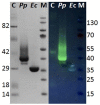Enzymatic Degradation of Aromatic and Aliphatic Polyesters by P. pastoris Expressed Cutinase 1 from Thermobifida cellulosilytica
- PMID: 28596765
- PMCID: PMC5443175
- DOI: 10.3389/fmicb.2017.00938
Enzymatic Degradation of Aromatic and Aliphatic Polyesters by P. pastoris Expressed Cutinase 1 from Thermobifida cellulosilytica
Abstract
To study hydrolysis of aromatic and aliphatic polyesters cutinase 1 from Thermobifida cellulosilytica (Thc_Cut1) was expressed in P. pastoris. No significant differences between the expression of native Thc_Cut1 and of two glycosylation site knock out mutants (Thc_Cut1_koAsn and Thc_Cut1_koST) concerning the total extracellular protein concentration and volumetric activity were observed. Hydrolysis of poly(ethylene terephthalate) (PET) was shown for all three enzymes based on quantification of released products by HPLC and similar concentrations of released terephthalic acid (TPA) and mono(2-hydroxyethyl) terephthalate (MHET) were detected for all enzymes. Both tested aliphatic polyesters poly(butylene succinate) (PBS) and poly(3-hydroxybutyrate-co-3-hydroxyvalerate) (PHBV) were hydrolyzed by Thc_Cut1 and Thc_Cut1_koST, although PBS was hydrolyzed to significantly higher extent than PHBV. These findings were also confirmed via quartz crystal microbalance (QCM) analysis; for PHBV only a small mass change was observed while the mass of PBS thin films decreased by 93% upon enzymatic hydrolysis with Thc_Cut1. Although both enzymes led to similar concentrations of released products upon hydrolysis of PET and PHBV, Thc_Cut1_koST was found to be significantly more active on PBS than the native Thc_Cut1. Hydrolysis of PBS films by Thc_Cut1 and Thc_Cut1_koST was followed by weight loss and scanning electron microscopy (SEM). Within 96 h of hydrolysis up to 92 and 41% of weight loss were detected with Thc_Cut1_koST and Thc_Cut1, respectively. Furthermore, SEM characterization of PBS films clearly showed that enzyme tretment resulted in morphological changes of the film surface.
Keywords: Pichia pastoris; Thermobifida cellulosilytica; aliphatic polyesters; cutinase; enzymatic hydrolysis; poly(3-hydroxybutyrate-co-3-hydroxyvalerate); poly(butylene succinate); poly(ethylene terephthalate).
Figures










Similar articles
-
Biomimetic Approach to Enhance Enzymatic Hydrolysis of the Synthetic Polyester Poly(1,4-butylene adipate): Fusing Binding Modules to Esterases.Biomacromolecules. 2015 Dec 14;16(12):3889-96. doi: 10.1021/acs.biomac.5b01219. Epub 2015 Nov 24. Biomacromolecules. 2015. PMID: 26566664
-
Substrate specificities of cutinases on aliphatic-aromatic polyesters and on their model substrates.N Biotechnol. 2016 Mar 25;33(2):295-304. doi: 10.1016/j.nbt.2015.11.004. Epub 2015 Nov 21. N Biotechnol. 2016. PMID: 26594021
-
Fusion of binding domains to Thermobifida cellulosilytica cutinase to tune sorption characteristics and enhancing PET hydrolysis.Biomacromolecules. 2013 Jun 10;14(6):1769-76. doi: 10.1021/bm400140u. Epub 2013 May 29. Biomacromolecules. 2013. PMID: 23718548
-
Enzymatic hydrolysis of poly(ethylene furanoate).J Biotechnol. 2016 Oct 10;235:47-53. doi: 10.1016/j.jbiotec.2016.02.006. Epub 2016 Feb 17. J Biotechnol. 2016. PMID: 26854948 Review.
-
Microbial degradation of aliphatic and aliphatic-aromatic co-polyesters.Appl Microbiol Biotechnol. 2014 Apr;98(8):3437-47. doi: 10.1007/s00253-014-5558-1. Epub 2014 Feb 13. Appl Microbiol Biotechnol. 2014. PMID: 24522729 Review.
Cited by
-
Engineering Microbes to Bio-Upcycle Polyethylene Terephthalate.Front Bioeng Biotechnol. 2021 May 28;9:656465. doi: 10.3389/fbioe.2021.656465. eCollection 2021. Front Bioeng Biotechnol. 2021. PMID: 34124018 Free PMC article. Review.
-
Eco-friendly approaches for mitigating plastic pollution: advancements and implications for a greener future.Biodegradation. 2024 Aug;35(5):493-518. doi: 10.1007/s10532-023-10062-1. Epub 2024 Feb 4. Biodegradation. 2024. PMID: 38310578 Review.
-
High Throughput Screening for New Fungal Polyester Hydrolyzing Enzymes.Front Microbiol. 2020 Apr 24;11:554. doi: 10.3389/fmicb.2020.00554. eCollection 2020. Front Microbiol. 2020. PMID: 32390956 Free PMC article.
-
Activity of an anaerobic Thermoanaerobacterales hydrolase on aliphatic and aromatic polyesters.Front Bioeng Biotechnol. 2025 Jan 17;12:1520680. doi: 10.3389/fbioe.2024.1520680. eCollection 2024. Front Bioeng Biotechnol. 2025. PMID: 39898275 Free PMC article.
-
Characterization of mycobacteria isolated from the Brazilian Atlantic Forest: a public health and bioprospection perspective.Front Microbiol. 2025 Apr 25;16:1558006. doi: 10.3389/fmicb.2025.1558006. eCollection 2025. Front Microbiol. 2025. PMID: 40351310 Free PMC article.
References
-
- Bretthauer R. K., Castellino F. J. (1999). Glycosylation of Pichia pastoris-derived proteins. Biotechnol. Appl. Biochem. 30(Pt 3), 193–200. - PubMed
-
- Brueckner T., Eberl A., Heumann S., Rabe M., Guebitz M. G. (2008). Enzymatic and chemical hydrolysis of poly(ethylene terephthalate) fabrics. Polym. Chem. 46, 6435–6443. 10.1002/pola.22952 - DOI
LinkOut - more resources
Full Text Sources
Other Literature Sources

